Saturday, March 13, 2021
Salute to Leeds and Northrup, part 2: Vreeland.
Following from Leeds and Northrup part 1.
Lately I've been studying and animating some old devices that followed the liquid soft analog path instead of the dry hard digital path. The dry path didn't win a decisive victory until around 1960.
Wet electronics came before dry. The first telegraphs used potential difference from wet batteries to form visible streams of electrolysis bubbles, one wire for each letter.
 Electrolysis is messy, so it receded quickly from everyday use into lab use.
Rehashing a couple of the wet devices, including both clocks and electronics:
The magnificent incomparable Ridhwan water clock, around 1200 AD:
Electrolysis is messy, so it receded quickly from everyday use into lab use.
Rehashing a couple of the wet devices, including both clocks and electronics:
The magnificent incomparable Ridhwan water clock, around 1200 AD:
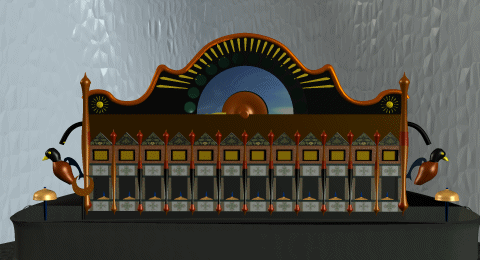 Electrolytic voltmeters:
Electrolytic voltmeters:
 The Tiffereau water-escapement clock:
The Tiffereau water-escapement clock:
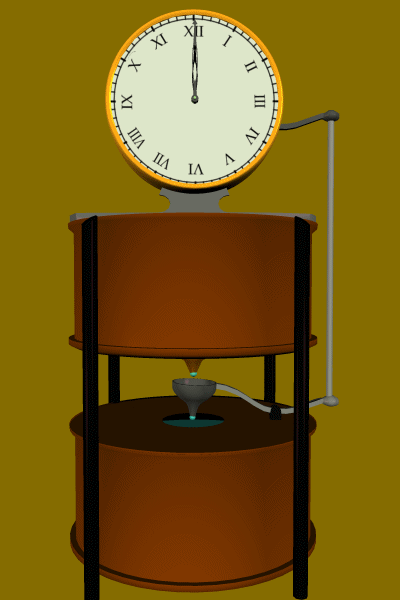 The Lukyanov water computer used water pressure to simulate graphs of various functions.
The Lukyanov water computer used water pressure to simulate graphs of various functions.
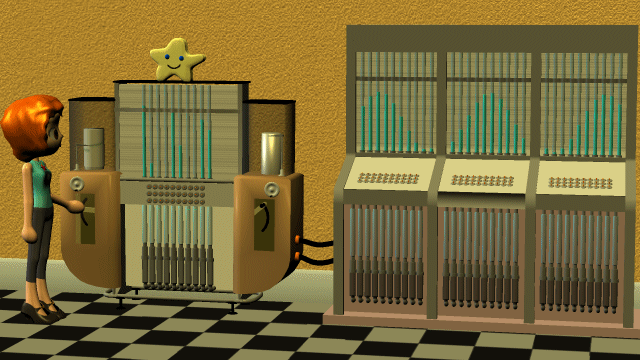 = = = =
Now we look at a Leeds and Northrup product that combined several of those techniques into a truly weird-looking machine. Weird or not, this machine occupied a unique position for 20 years, performing one important task better than anything else.
The Vreeland Oscillator was invented in 1906 (of course) and used into the '30s, long after dry vacuum tube circuits were highly sophisticated. Experimenters and metrologists agreed that Vreeland's output was significantly more stable and pure than any other variable oscillator available at the time. Tuning forks for audio freqs and crystals for radio freqs were more stable, but they weren't variable.
= = = =
Now we look at a Leeds and Northrup product that combined several of those techniques into a truly weird-looking machine. Weird or not, this machine occupied a unique position for 20 years, performing one important task better than anything else.
The Vreeland Oscillator was invented in 1906 (of course) and used into the '30s, long after dry vacuum tube circuits were highly sophisticated. Experimenters and metrologists agreed that Vreeland's output was significantly more stable and pure than any other variable oscillator available at the time. Tuning forks for audio freqs and crystals for radio freqs were more stable, but they weren't variable.
 Here's the real thing as seen in the LN catalog. This is the only available picture, with no labels or side views, so I had to make several (probably unfounded) assumptions about the various controls. The knife switches on top clearly switch in the igniter cathode and oscillating anodes. Rotary switches probably vary the resistances. The 'radiator' and the big handle on the left are more mysterious. The radiator might be the capacitor because it looks like a pair of plates, and the handle might move the radiator in and out to adjust the spacing. But the description says that the capacitor is inside the box, so this explanation is dubious.
[** See correction below.]
The essential parts are a mercury vapor tube sandwiched between two inductors that pull the arc in opposite directions. The tube is hard to see in the catalog illustration.
Here's the real thing as seen in the LN catalog. This is the only available picture, with no labels or side views, so I had to make several (probably unfounded) assumptions about the various controls. The knife switches on top clearly switch in the igniter cathode and oscillating anodes. Rotary switches probably vary the resistances. The 'radiator' and the big handle on the left are more mysterious. The radiator might be the capacitor because it looks like a pair of plates, and the handle might move the radiator in and out to adjust the spacing. But the description says that the capacitor is inside the box, so this explanation is dubious.
[** See correction below.]
The essential parts are a mercury vapor tube sandwiched between two inductors that pull the arc in opposite directions. The tube is hard to see in the catalog illustration.
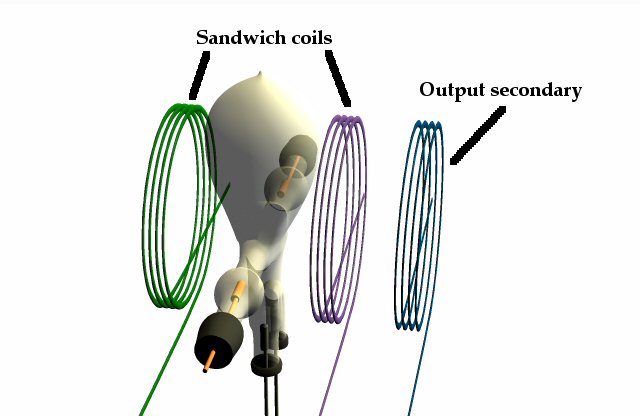 The tube itself has a cathode that emits electrons, two anodes that alternately attract electrons, and an igniter cathode that is energized briefly with higher voltage to get the pool of mercury heated into vapor.
The tube itself has a cathode that emits electrons, two anodes that alternately attract electrons, and an igniter cathode that is energized briefly with higher voltage to get the pool of mercury heated into vapor.
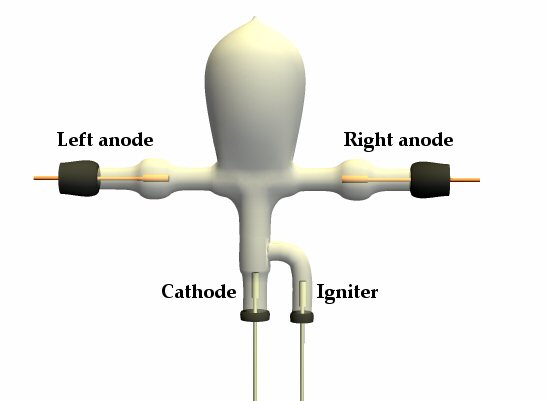 = = = = =
Vreeland was essentially a lightning pendulum.
A lightning stroke forms a complicated and wildly indirect path, then repeats the path several times. The path is indirect because it jumps from one air molecule to another, finding the nearest available molecule at each jump. The nearest is rarely on a direct line to the ground. After ionizing those sections of air, the discharge is able to take the same path repeatedly until wind moves the air around. Like clearing a curvy road to avoid hills and property lines, then reusing the road.
By contrast, a discharge in a vacuum will always take the shortest path from negative to positive. Each electron is pulled in the same direction, and has no reason to detour into more favorable zones. There are no hills or property lines in a vacuum, and no road to reuse. Paths start instantly and end instantly.
The direct predecessor of the Vreeland is the coherer, another lightning-style device. Coherers detect faint radio waves by creating a conductive path through metal powder:
= = = = =
Vreeland was essentially a lightning pendulum.
A lightning stroke forms a complicated and wildly indirect path, then repeats the path several times. The path is indirect because it jumps from one air molecule to another, finding the nearest available molecule at each jump. The nearest is rarely on a direct line to the ground. After ionizing those sections of air, the discharge is able to take the same path repeatedly until wind moves the air around. Like clearing a curvy road to avoid hills and property lines, then reusing the road.
By contrast, a discharge in a vacuum will always take the shortest path from negative to positive. Each electron is pulled in the same direction, and has no reason to detour into more favorable zones. There are no hills or property lines in a vacuum, and no road to reuse. Paths start instantly and end instantly.
The direct predecessor of the Vreeland is the coherer, another lightning-style device. Coherers detect faint radio waves by creating a conductive path through metal powder:
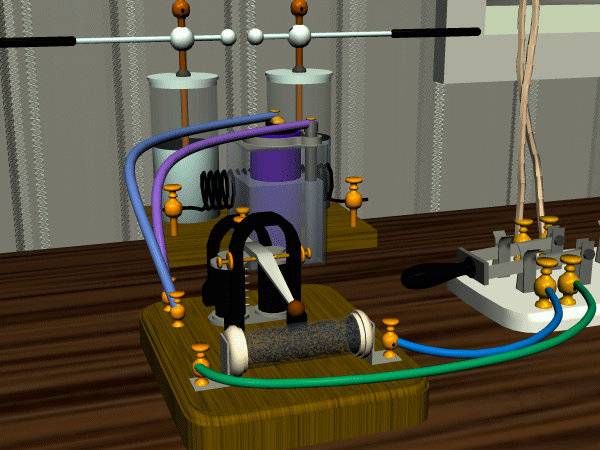 Vreeland created a cohering path in mercury vapor, forming a pendulum with escapement.
Vreeland created a cohering path in mercury vapor, forming a pendulum with escapement.
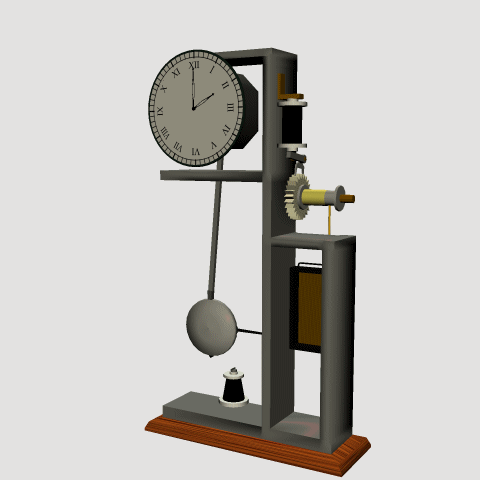 A clock pendulum uses the resonance of a heavy weight, swinging in a restricted range, to maintain frequency. At each endpoint of the range, the escapement skips to the next tooth on the drive gear, giving a small burst of energy to the pendulum. The drive gear is pulled by a steady weight or spring.
Vreeland uses the smooth shifting of the mercury-vapor lightning between anodes as the pendulum, and the time constant of a capacitor through a resistance as the weight. A capacitor never sends steady DC; it allows a single push or pull then stops.
A clock pendulum uses the resonance of a heavy weight, swinging in a restricted range, to maintain frequency. At each endpoint of the range, the escapement skips to the next tooth on the drive gear, giving a small burst of energy to the pendulum. The drive gear is pulled by a steady weight or spring.
Vreeland uses the smooth shifting of the mercury-vapor lightning between anodes as the pendulum, and the time constant of a capacitor through a resistance as the weight. A capacitor never sends steady DC; it allows a single push or pull then stops.
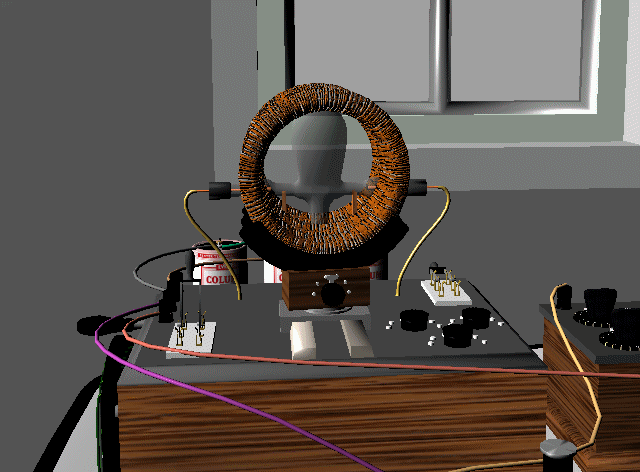 The arc shifts back and forth between the anodes, pulled by the sandwich coils. Each change of conduction then triggers the sandwich coils to reverse their magnetic field, and gives a brief burst of electrons into the resonating parts. Result: oscillation.
What was actually happening in the wires and resistors and capacitors? Oddly, we have better detail on this level, thanks to a thesis written in 1920 by Arthur Aardal. He drew a number of useful schematics and explained how the various parts moved back and forth. Here's a simplified version, treating the two arcs in the tube as a relay that switches back and forth under the influence of the two sandwich coils.
The arc shifts back and forth between the anodes, pulled by the sandwich coils. Each change of conduction then triggers the sandwich coils to reverse their magnetic field, and gives a brief burst of electrons into the resonating parts. Result: oscillation.
What was actually happening in the wires and resistors and capacitors? Oddly, we have better detail on this level, thanks to a thesis written in 1920 by Arthur Aardal. He drew a number of useful schematics and explained how the various parts moved back and forth. Here's a simplified version, treating the two arcs in the tube as a relay that switches back and forth under the influence of the two sandwich coils.
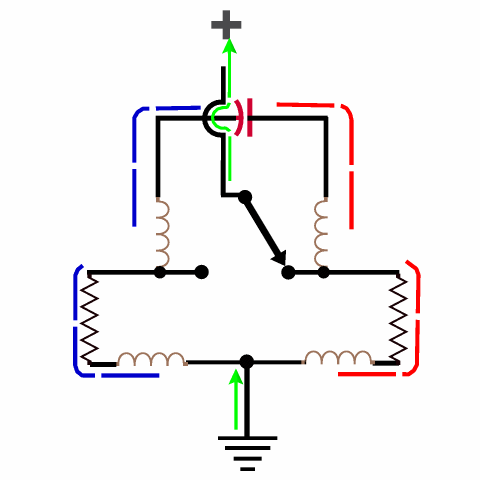 The DC power supply always sends electrons upward from ground to positive. The electrons take different paths on the opposite sides of the cycle. On one side they flow upward through the left branch, then clockwise into the capacitor. On the other half of the cycle electrons flow upward through the right branch, then push counterclockwise into the capacitor.
Finally, the output was taken from the separate secondary coil, which could slide forward and backward to change amplitude, and turn to change phase. (I'm animating the motions here, but in reality they would be set once and left alone.) Thus the output audio was completely AC and completely isolated from the high-current arc.
The DC power supply always sends electrons upward from ground to positive. The electrons take different paths on the opposite sides of the cycle. On one side they flow upward through the left branch, then clockwise into the capacitor. On the other half of the cycle electrons flow upward through the right branch, then push counterclockwise into the capacitor.
Finally, the output was taken from the separate secondary coil, which could slide forward and backward to change amplitude, and turn to change phase. (I'm animating the motions here, but in reality they would be set once and left alone.) Thus the output audio was completely AC and completely isolated from the high-current arc.
 Polistra is using the Vreeland as the source of AC for a conductivity test, identical to the first Leeds and Northrup setup except for the oscillator. Vreelands were used extensively for this type of work, and also for medical electrotherapy because of the clean waves and total isolation.
= = = = =
Frederick King Vreeland, the inventor, was clearly trying to establish an entire wet branch of electronics. He patented a number of wet coherers. Later he seems to have surrendered to the dry trend, patenting several ordinary receiver circuits using ordinary vacuum tubes. It's hard to find info on Frederick King Vreeland online because an entirely different Frederick Dalziel Vreeland, son of Diana Vreeland, went into Deepstate politics and left a much broader trail of ionization. I haven't found any biographical info on the correct Frederick Vreeland, only his patents and devices plus a few speeches at electrical conventions. The two Fredericks might be distantly related, but they're not father and son.
= = = = =
** Correction on the 'radiator'. Found it accidentally when looking for other things. It's a high-current rheostat or resistance selector, to vary the main 110 V input. The lever doesn't go in and out, it's pivoted at the bottom and goes back and forth across the hefty resistors.
Polistra is using the Vreeland as the source of AC for a conductivity test, identical to the first Leeds and Northrup setup except for the oscillator. Vreelands were used extensively for this type of work, and also for medical electrotherapy because of the clean waves and total isolation.
= = = = =
Frederick King Vreeland, the inventor, was clearly trying to establish an entire wet branch of electronics. He patented a number of wet coherers. Later he seems to have surrendered to the dry trend, patenting several ordinary receiver circuits using ordinary vacuum tubes. It's hard to find info on Frederick King Vreeland online because an entirely different Frederick Dalziel Vreeland, son of Diana Vreeland, went into Deepstate politics and left a much broader trail of ionization. I haven't found any biographical info on the correct Frederick Vreeland, only his patents and devices plus a few speeches at electrical conventions. The two Fredericks might be distantly related, but they're not father and son.
= = = = =
** Correction on the 'radiator'. Found it accidentally when looking for other things. It's a high-current rheostat or resistance selector, to vary the main 110 V input. The lever doesn't go in and out, it's pivoted at the bottom and goes back and forth across the hefty resistors.
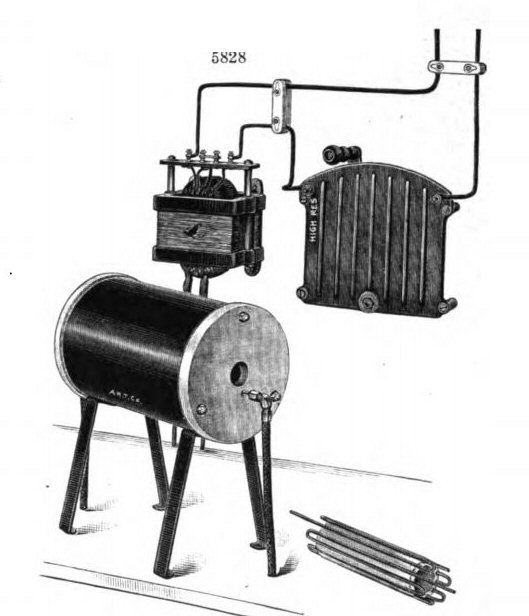 Here it's part of an electric furnace, found on p538 of an Arthur Thomas scientific apparatus catalog.
= = = = =
Continued in part 3.
Here it's part of an electric furnace, found on p538 of an Arthur Thomas scientific apparatus catalog.
= = = = =
Continued in part 3.
 Electrolysis is messy, so it receded quickly from everyday use into lab use.
Rehashing a couple of the wet devices, including both clocks and electronics:
The magnificent incomparable Ridhwan water clock, around 1200 AD:
Electrolysis is messy, so it receded quickly from everyday use into lab use.
Rehashing a couple of the wet devices, including both clocks and electronics:
The magnificent incomparable Ridhwan water clock, around 1200 AD:
 Electrolytic voltmeters:
Electrolytic voltmeters:
 The Tiffereau water-escapement clock:
The Tiffereau water-escapement clock:
 The Lukyanov water computer used water pressure to simulate graphs of various functions.
The Lukyanov water computer used water pressure to simulate graphs of various functions.
 = = = =
Now we look at a Leeds and Northrup product that combined several of those techniques into a truly weird-looking machine. Weird or not, this machine occupied a unique position for 20 years, performing one important task better than anything else.
The Vreeland Oscillator was invented in 1906 (of course) and used into the '30s, long after dry vacuum tube circuits were highly sophisticated. Experimenters and metrologists agreed that Vreeland's output was significantly more stable and pure than any other variable oscillator available at the time. Tuning forks for audio freqs and crystals for radio freqs were more stable, but they weren't variable.
= = = =
Now we look at a Leeds and Northrup product that combined several of those techniques into a truly weird-looking machine. Weird or not, this machine occupied a unique position for 20 years, performing one important task better than anything else.
The Vreeland Oscillator was invented in 1906 (of course) and used into the '30s, long after dry vacuum tube circuits were highly sophisticated. Experimenters and metrologists agreed that Vreeland's output was significantly more stable and pure than any other variable oscillator available at the time. Tuning forks for audio freqs and crystals for radio freqs were more stable, but they weren't variable.
 Here's the real thing as seen in the LN catalog. This is the only available picture, with no labels or side views, so I had to make several (probably unfounded) assumptions about the various controls. The knife switches on top clearly switch in the igniter cathode and oscillating anodes. Rotary switches probably vary the resistances. The 'radiator' and the big handle on the left are more mysterious. The radiator might be the capacitor because it looks like a pair of plates, and the handle might move the radiator in and out to adjust the spacing. But the description says that the capacitor is inside the box, so this explanation is dubious.
[** See correction below.]
The essential parts are a mercury vapor tube sandwiched between two inductors that pull the arc in opposite directions. The tube is hard to see in the catalog illustration.
Here's the real thing as seen in the LN catalog. This is the only available picture, with no labels or side views, so I had to make several (probably unfounded) assumptions about the various controls. The knife switches on top clearly switch in the igniter cathode and oscillating anodes. Rotary switches probably vary the resistances. The 'radiator' and the big handle on the left are more mysterious. The radiator might be the capacitor because it looks like a pair of plates, and the handle might move the radiator in and out to adjust the spacing. But the description says that the capacitor is inside the box, so this explanation is dubious.
[** See correction below.]
The essential parts are a mercury vapor tube sandwiched between two inductors that pull the arc in opposite directions. The tube is hard to see in the catalog illustration.
 The tube itself has a cathode that emits electrons, two anodes that alternately attract electrons, and an igniter cathode that is energized briefly with higher voltage to get the pool of mercury heated into vapor.
The tube itself has a cathode that emits electrons, two anodes that alternately attract electrons, and an igniter cathode that is energized briefly with higher voltage to get the pool of mercury heated into vapor.
 = = = = =
Vreeland was essentially a lightning pendulum.
A lightning stroke forms a complicated and wildly indirect path, then repeats the path several times. The path is indirect because it jumps from one air molecule to another, finding the nearest available molecule at each jump. The nearest is rarely on a direct line to the ground. After ionizing those sections of air, the discharge is able to take the same path repeatedly until wind moves the air around. Like clearing a curvy road to avoid hills and property lines, then reusing the road.
By contrast, a discharge in a vacuum will always take the shortest path from negative to positive. Each electron is pulled in the same direction, and has no reason to detour into more favorable zones. There are no hills or property lines in a vacuum, and no road to reuse. Paths start instantly and end instantly.
The direct predecessor of the Vreeland is the coherer, another lightning-style device. Coherers detect faint radio waves by creating a conductive path through metal powder:
= = = = =
Vreeland was essentially a lightning pendulum.
A lightning stroke forms a complicated and wildly indirect path, then repeats the path several times. The path is indirect because it jumps from one air molecule to another, finding the nearest available molecule at each jump. The nearest is rarely on a direct line to the ground. After ionizing those sections of air, the discharge is able to take the same path repeatedly until wind moves the air around. Like clearing a curvy road to avoid hills and property lines, then reusing the road.
By contrast, a discharge in a vacuum will always take the shortest path from negative to positive. Each electron is pulled in the same direction, and has no reason to detour into more favorable zones. There are no hills or property lines in a vacuum, and no road to reuse. Paths start instantly and end instantly.
The direct predecessor of the Vreeland is the coherer, another lightning-style device. Coherers detect faint radio waves by creating a conductive path through metal powder:
 Vreeland created a cohering path in mercury vapor, forming a pendulum with escapement.
Vreeland created a cohering path in mercury vapor, forming a pendulum with escapement.
 A clock pendulum uses the resonance of a heavy weight, swinging in a restricted range, to maintain frequency. At each endpoint of the range, the escapement skips to the next tooth on the drive gear, giving a small burst of energy to the pendulum. The drive gear is pulled by a steady weight or spring.
Vreeland uses the smooth shifting of the mercury-vapor lightning between anodes as the pendulum, and the time constant of a capacitor through a resistance as the weight. A capacitor never sends steady DC; it allows a single push or pull then stops.
A clock pendulum uses the resonance of a heavy weight, swinging in a restricted range, to maintain frequency. At each endpoint of the range, the escapement skips to the next tooth on the drive gear, giving a small burst of energy to the pendulum. The drive gear is pulled by a steady weight or spring.
Vreeland uses the smooth shifting of the mercury-vapor lightning between anodes as the pendulum, and the time constant of a capacitor through a resistance as the weight. A capacitor never sends steady DC; it allows a single push or pull then stops.
 The arc shifts back and forth between the anodes, pulled by the sandwich coils. Each change of conduction then triggers the sandwich coils to reverse their magnetic field, and gives a brief burst of electrons into the resonating parts. Result: oscillation.
What was actually happening in the wires and resistors and capacitors? Oddly, we have better detail on this level, thanks to a thesis written in 1920 by Arthur Aardal. He drew a number of useful schematics and explained how the various parts moved back and forth. Here's a simplified version, treating the two arcs in the tube as a relay that switches back and forth under the influence of the two sandwich coils.
The arc shifts back and forth between the anodes, pulled by the sandwich coils. Each change of conduction then triggers the sandwich coils to reverse their magnetic field, and gives a brief burst of electrons into the resonating parts. Result: oscillation.
What was actually happening in the wires and resistors and capacitors? Oddly, we have better detail on this level, thanks to a thesis written in 1920 by Arthur Aardal. He drew a number of useful schematics and explained how the various parts moved back and forth. Here's a simplified version, treating the two arcs in the tube as a relay that switches back and forth under the influence of the two sandwich coils.
 The DC power supply always sends electrons upward from ground to positive. The electrons take different paths on the opposite sides of the cycle. On one side they flow upward through the left branch, then clockwise into the capacitor. On the other half of the cycle electrons flow upward through the right branch, then push counterclockwise into the capacitor.
Finally, the output was taken from the separate secondary coil, which could slide forward and backward to change amplitude, and turn to change phase. (I'm animating the motions here, but in reality they would be set once and left alone.) Thus the output audio was completely AC and completely isolated from the high-current arc.
The DC power supply always sends electrons upward from ground to positive. The electrons take different paths on the opposite sides of the cycle. On one side they flow upward through the left branch, then clockwise into the capacitor. On the other half of the cycle electrons flow upward through the right branch, then push counterclockwise into the capacitor.
Finally, the output was taken from the separate secondary coil, which could slide forward and backward to change amplitude, and turn to change phase. (I'm animating the motions here, but in reality they would be set once and left alone.) Thus the output audio was completely AC and completely isolated from the high-current arc.
 Polistra is using the Vreeland as the source of AC for a conductivity test, identical to the first Leeds and Northrup setup except for the oscillator. Vreelands were used extensively for this type of work, and also for medical electrotherapy because of the clean waves and total isolation.
= = = = =
Frederick King Vreeland, the inventor, was clearly trying to establish an entire wet branch of electronics. He patented a number of wet coherers. Later he seems to have surrendered to the dry trend, patenting several ordinary receiver circuits using ordinary vacuum tubes. It's hard to find info on Frederick King Vreeland online because an entirely different Frederick Dalziel Vreeland, son of Diana Vreeland, went into Deepstate politics and left a much broader trail of ionization. I haven't found any biographical info on the correct Frederick Vreeland, only his patents and devices plus a few speeches at electrical conventions. The two Fredericks might be distantly related, but they're not father and son.
= = = = =
** Correction on the 'radiator'. Found it accidentally when looking for other things. It's a high-current rheostat or resistance selector, to vary the main 110 V input. The lever doesn't go in and out, it's pivoted at the bottom and goes back and forth across the hefty resistors.
Polistra is using the Vreeland as the source of AC for a conductivity test, identical to the first Leeds and Northrup setup except for the oscillator. Vreelands were used extensively for this type of work, and also for medical electrotherapy because of the clean waves and total isolation.
= = = = =
Frederick King Vreeland, the inventor, was clearly trying to establish an entire wet branch of electronics. He patented a number of wet coherers. Later he seems to have surrendered to the dry trend, patenting several ordinary receiver circuits using ordinary vacuum tubes. It's hard to find info on Frederick King Vreeland online because an entirely different Frederick Dalziel Vreeland, son of Diana Vreeland, went into Deepstate politics and left a much broader trail of ionization. I haven't found any biographical info on the correct Frederick Vreeland, only his patents and devices plus a few speeches at electrical conventions. The two Fredericks might be distantly related, but they're not father and son.
= = = = =
** Correction on the 'radiator'. Found it accidentally when looking for other things. It's a high-current rheostat or resistance selector, to vary the main 110 V input. The lever doesn't go in and out, it's pivoted at the bottom and goes back and forth across the hefty resistors.
 Here it's part of an electric furnace, found on p538 of an Arthur Thomas scientific apparatus catalog.
= = = = =
Continued in part 3.
Here it's part of an electric furnace, found on p538 of an Arthur Thomas scientific apparatus catalog.
= = = = =
Continued in part 3.
